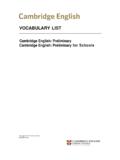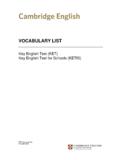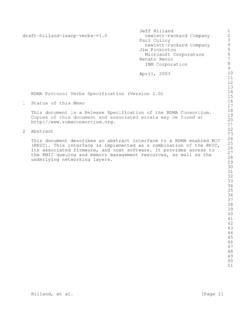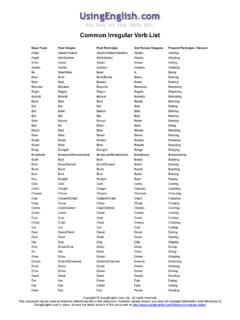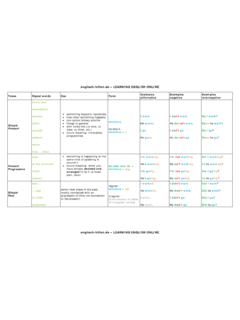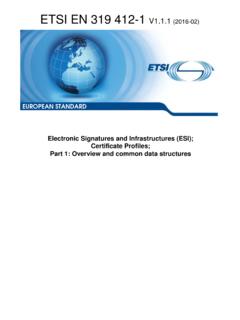Transcription of Curriculum: Know, Understand, Do - Carol Ann Tomlinson
1 Day One AM. curriculum : know , understand , Do Principles into Practice Sandra Page Chapel Hill, NC 27516. 919/636-1450. Clear Learning Goals mean: What should students know : (often represented in bulleted format). Facts Dates Definitions Rules People Places Vocabulary Information Students will be able to DO: (represented with verbs). Basic skills Communication Planning/Organization Thinking skills Evaluation Working collaboratively Skills of the discipline: mapping, graphing, collecting data, show Students will understand that : (best stated as a sentence which includes concept-based thought). Essential questions Theories Big ideas Important generalizations Thesis-like statements 2.
2 Understandings vs. Knowledge Essential Understandings Knowledge Open; arguable One right answer Thought-provoking Factual Higher order Definition Require support Prompt recall or the noticing Recur, possibly in other subject the answer areas Meant to efficiently answered 3. Juicy Verbs compose influence adopt unify devise promote elaborate designate detail substitute merchandize limit deconstruct prove formulate structure predict simulate shadow illustrate propose tailor inscribe refresh eliminate transform wonder transfer improve advise visualize reflect expand emphasize access concentrate minimize convert immerse approximate connect ponder justify regroup portray design compete simulate incorporate concentrate disguise modify produce compartmentalize personify anchor energize integrate uncover deviate Major Concepts and Subconcepts These are the written statements of truth, the core to the meaning(s) of the lesson(s) or unit.
3 These are what connect the parts of a subject to the student's life and to other subjects. It is through the understanding component of instruction that we teach our students to truly grasp the point of the lesson or the experience. Understandings are purposeful. They focus on the key ideas that require students to understand information and make connections while evaluating the relationships that exist within the understandings. Discipline-based Concepts Art-color, shape, line, form, texture, negative space Literature-perception, heroes and antiheroes, motivation, interactions, voice Mathematics-number, ration, proportion, probability, quantification Music-pitch, melody, tempo, harmony, timbre Physical Education-movement, rules, play, effort, quality, space, strategy Science-classification, evolution, cycle, matter, order Social Science- governance, culture, revolution, conflict.
4 And cooperation Concept Words Reflect/ Reflection Completion Power Timeliness Scale/Proportion Security Justice Balance Implications Explore/Exploration Prove/Proof Pattern Charm Continuum Token Unity Community Restore/Restoration Independence Symbol/Symbolism Part/Whole Reduce/ Reduction Interdependence Coverage System Heritage Revision Compromise Relate/Relationship Colonization Improvement Collaborate/Collaboratio Connect/Connection Attributes n Migration Checks/Balances Archetype Illustrate/Illustration Organize/. Costs/Benefits Limitation Stewardship Organization Respect Evolve/Evolution Excellence Regions Isolate/Isolation Direct/Direction Freedom Encapsulate/.
5 Shape Responsibility Segmentation Encapsulation Style Choice Structure Value Transportation Design Construct/ Construction Attitude Fashion Heroes Revolution Light Construction Beauty Movement Culture Compile/Compilation Control Expand/Expansion Point of View/ Perspective Spiral/Circle Metamorphosis Create/Creation Applications Endurance Conflict Action/Reaction Give/Take Contrast Growth Predict/Prediction Infancy/Maturity Improvement Measure/Measurement Diversity Bridge/Link Change Equate/Equal/Equation Transform/ Transformation Discipline KUD Sorting Activity From Professional Development for Differentiating Instruction: An ASCD Action Tool By Cindy Strickland, ASCD.
6 Day One PM. Principles into Practice Assessment Sandra Page 919/636-1450. Pre-Assessment Questions to Ponder for Planning 1. What are the KUDs? What are the essential knowledge, understanding, and skill that form the core of the unit? 2. What prerequisite knowledge, understanding, and skill should students have in order to succeed with the unit? 3. What common misunderstandings do students often have about the unit's knowledge, understandings, or skills? 4. What questions can I ask that appropriately sample the unit's KUDs? 5. What is a reasonable amount of time to provide for the pre-assessment? 6. Should it be administered in one sitting, or across several? 7. How long before the start of a new unit should the pre-assessment be administered?
7 (I need time to review it, reflect on it, and plan for groupings and task with these results.). 8. Are there students who would benefit from differentiating the way the pre- assessment is written, designed, or administered? from Assessment and Student Success in a Differentiated 10. Classroom by Carol Ann Tomlinson and Tonya R. Moon Ongoing, Formative Assessments: Design and Use 1. Does the task or unit have clear KUDs reflecting the standards? 2. What are the KUDs being checked on this ongoing assessment? 3. What prerequisite knowledge, understanding, and skill should be checked at this juncture to ensure that students are ready to move ahead? 4. Are there common misunderstandings that should be assessed at this point in the learning cycle?
8 5. Are there students who would benefit from differentiation in the way the assessment is written, designed, or administered? 6. How will I provide feedback to students on the formative assessment that builds trust, is specific and clear, focused, timely, differentiated and invites follow-up? 7. Based on analysis of meaningful patterns, what does this student or cluster of students needs as the unit continues in order to facilitate maximum growth toward the essential goals of the unit and beyond them, when appropriate? 8. Given what I know of students' varied approaches to learning, how might I design upcoming lessons and tasks so that students have opportunities to learn in ways that make the learning process more inviting and more successful?
9 9. How does my evolving knowledge of students' interests suggest I might help students connect upcoming learning goals with their lives, experiences, strengths, and passions? 10. In what ways does the assessment information help me reflect on and refine my thinking, instructional planning, and instructional practices? from Assessment and Student Success in a Differentiated 11. Classroom by Carol Ann Tomlinson and Tonya R. Moon Ongoing assessment & adjustment of instruction Define: Using informal and formal methods to find out about students' readiness levels, learning preferences, and interests before beginning instruction, during instruction (both are formative assessments) and after completion of teaching (summative) and then using that information to change how and what will be taught next.
10 What might that look like in a classroom or school? Teachers preassess students to determine level of understanding and then group students by readiness for different tasks' difficulty. Sandra Page 2010. THINKING ABOUT. ON-GOING ASSESSMENT. STUDENT DATA SOURCES TEACHER DATA MECHANISMS. 1. Journal entry 1. Anecdotal records 2. Short answer test 2. Observation by checklist 3. Open response test 3. Skills checklist 4. Class discussion 4. Home learning 5. Small group interaction 5. Notebook 6. Teacher student 6. Oral response conference 7. Portfolio entry 7. Assessment stations 8. Exhibition 8. Exit cards 9. Culminating product 9. Problem posing 10. Question writing 10. Performance tasks and rubrics 11.




